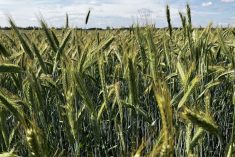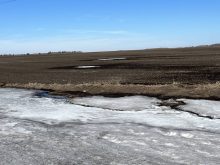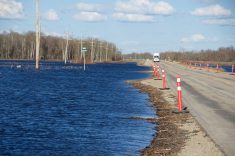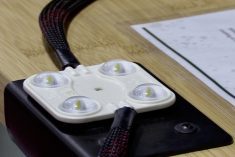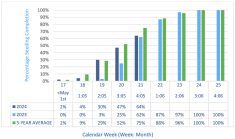Manitoba is sitting pretty for soil moisture as the growing season looms, according to one crops and weather specialist.
Bruce Burnett, director of crops and weather for MarketsFarm, a division of Glacier FarmMedia, said things get drier as one looks further west in the Prairies, but Manitoba’s soil moisture is good — maybe even verging on too good.
“Soil moisture levels, especially to start the spring, look to be OK, if not maybe a little bit excessive in areas in the eastern Prairies where we’ve had some late season snow, along with a lot of flood waters coming up from the United States,” he said.
Read Also

Journal pulls long-cited glyphosate study for ethics violations
The journal Regulatory Toxicology and Pharmacology has retracted a 2000 Monsanto-linked glyphosate review, drawing new scrutiny as Bayer faces mounting legal pressure.
Why it matters: Manitoba looks lucky on soil moisture, although temperature might throw a wrench in the works.
Burnett added that winter was relatively mild across the Prairies, with the coolest temperatures seen in the eastern half of the region.
But while Manitoba dodged most of the brutal cold one might expect from a province with a capital nick-named ‘Winter-peg,’ the mercury was also slow to rise as the year crossed what would typically be considered the starting line for the spring melt.

Last month, climatologists marveled that the province made it through March without a single daily high above freezing, distinctly unusual when compared to historical trends.
In terms of soil moisture, cool temperatures in late winter and early spring kept soils frozen, limiting potential for infiltration.
“Fortunately, on a lot of the eastern Prairies, we really did have very good subsoil moisture levels, so it’s not gonna make too big of a difference, not getting the optimal infiltration this year,” Burnett said.
“I think we’re gonna be quite fine. We’ll start off with decent soil moisture levels as we go into the spring seeding season.”
Timi Ojo, agriculture meteorology specialist for Manitoba Agriculture, echoed Burnett.
“I wouldn’t expect that we would have an issue with soil moisture this year,” he said.
“In most places, soils were sitting at about 80 to 100 per cent of their available water holding capacity from the fall.”

The cool start to the growing year likely didn’t do much to affect soil moisture for the season, he added. Nor did late snowstorms that tracked through the province in the first week of April. Soil moisture levels would look similar in a typical spring as they do now, especially with water holding capacity numbers where they now sit, Ojo said.
“Most of the precipitation received over the winter doesn’t actually have a significant impact directly on soil moisture,” he said. “The two main pathways for precipitation are either to infiltrate the soil or to flow over land. And in the spring, one of the things we see is that most of the precipitation is partitioned towards overland runoff.”
Patches of the province have greater soil moisture concerns. Areas near Duck Mountain Provincial Park, for example, were dry in fall 2022, and moisture is a perennial concern in areas with low water-holding capacity soils like the southwest corner around Melita and Pierson.
Even in those areas, Ojo says producers shouldn’t panic.
“I wouldn’t be too worried about it,” he said. “It’s quite early. We expect to have some spring showers coming through.”
Farmers are also unlikely to see seeding delays similar to last year, after the province was hammered with three consecutive Colorado lows. However, a different weather-related issue might hamper efforts to get crops established this year, said Ojo.
With soils still frozen and below-normal temperatures projected between now and June, soil temperature is a potential concern.
“We likely won’t have as much warming as we’d like,” Ojo said, adding that farmers should
“be mindful of that and watch the soil temperature at seeding depth.”
Elsewhere on the Prairies
The soil moisture situation seems reasonable in most of the eastern part of Saskatchewan, except for the extreme southeast corner. Moving west, things are dry.
Matt Struthers is a crop extension specialist with the Moose Jaw office of Saskatchewan Agriculture and editor of the province’s weekly crop report. He said south and west of his location, the moisture picture gets “a little spotty.” Some areas had adequate snowfall this winter and others were relatively bare.
“As you move into the southwest, around Swift Current, Shaunovan and Consul, it’s a bit drier this spring, and they’re likely to need some timely spring rains,” he said.
Speaking with Glacier FarmMedia on April 11, he noted the slower start to spring might be a positive, provided conditions don’t get too late for timely seeding.
“Being that it’s a bit later, that may help conserve that moisture and aid germination once we get that seed into the ground,” he said. “But of course, people, including me, might be a little anxious about how long we might be delayed.”

The past few seasons have been an exercise in managing volatility, he noted. Spring 2021 was very dry. Spring 2022 was extremely wet in the eastern half of the province, and this year there’s a late spring.
“Historically, we’ve been here before. We’ll be here again. I don’t really start to worry until July rolls around and another heat dome sets up,” Struthers said.
He also noted some good news accompanying the slow spring. Cooler weather and moist conditions are likely taking a bite out of grasshopper populations as larvae and nymphs succumb to the conditions.
“Last year this area had a big problem,” he said. “We had a dry spring, it warmed up quickly, and the grasshopper population thrived.”
In Alberta, Laura Richard, an agro-climate analyst with Agriculture and Agri-Food Canada, says a long, cold winter has made soil moisture detection difficult due to extended snow cover.
Going by winter precipitation, however, soil moisture in southern Alberta looks strong and the rest of the province, particularly the central, northeast and Peace River regions, is going to need a spring recharge as it continues to bounce back from the 2021-22 drought.
“Generally speaking, regions south of Calgary have gotten between 60 and 115 per cent of average precipitation, so those are our areas of real recovery,” she said. “The southern areas also received good fall moisture going into winter.
“Unfortunately, there’s a big swath between Edmonton and Calgary, as well as the northeast, where they’ve only received 40 to 60 per cent of normal precipitation. That’s not dire, but given the dry conditions these areas went into winter with, there’s still some concern over the soil moisture.”
The same goes for parts of the Peace River region.
If there’s any comfort for producers in drier areas, it’s that Alberta farmers generally get spring rains.
“We know for sure that it’s the rains in June and July that really determine the quality of the crops and that’s how Alberta actually gets the majority of its moisture,” said Richard.
Snowpack generally looks good in dry areas around Edmonton and the Peace River but moisture is difficult to calculate until it’s melted.
Weather watching
Burnett says it’s going to be a balancing act between soil moisture giving crops their start and timely rainfall in the growing season.
“Most of the precipitation that we receive in the Prairies are in the May-June-July-August period,” he said. “If we don’t get normal precipitation during that time frame, and especially if we don’t get it at the right times, then we certainly see crop stress developing.”
Areas with the lowest subsoil moisture are at highest risk.
“The problem with that is we have no, shall we say, capacity to withstand severe periods of drought during the growing season,” Burnett said.
“So if you get into a dry spell in, let’s say, the first three weeks of July, then you see a lot of stress developing in the crops.”
As the season wears on, Burnett will keep an eye on the western part of the Prairies.
“That’s specifically the area I’m most concerned about,” he said.
In the short term, he’ll watch southern Manitoba, particularly the Red River Valley, as it works its way through any flooding issues and the late spring.
“It’s probably going to be about another three or four weeks before some farmers get on the fields, just because of how much moisture there is around,” he said.
Shifting weather patterns are an additional factor. The La Nina phase has ended, to be replaced by a neutral phase that’s likely to be replaced by El Nino.
“So that means that we probably are gonna see a different weather pattern than we’ve been experiencing for the last few years,” Burnett said.
– With files from Don Norman and Jeff Melchior




